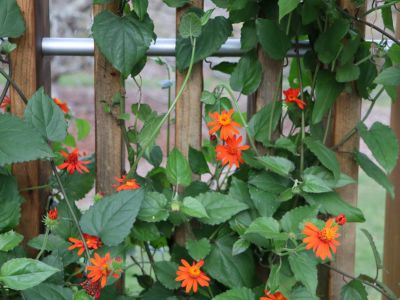Why Grow Drought Tolerant Climbing Plants?
Growing drought tolerant vines satisfies several criteria. The most obvious being their need for very little water; they aren’t a cacti though, and do require some water. Often hand in hand with lack of water is oppressive heat. Growing drought tolerant vines creates a natural arbor of shade that is often ten degrees cooler than the surrounding, sun-drenched landscape. Vines that can handle drought can also be planted right up against the house, again lending a curtain of greenery while cooling the inside temperature. Vines for hot gardens provide wind protection as well, thus reducing dust, sun glare, and reflected heat. Vines in general, add an interesting vertical line in the landscape and can act as a divider, barrier, or privacy screen. Many vines have gorgeous flowers that add color and aroma. All this without taking up much ground space.
Types of Vines That Can Handle Drought
There are four main types of vines:
Twining vines have stems that wrap around any available support. Tendril climbing vines are vines that support themselves via tendrils and side shoots up anything they can grab onto. These and twining types are suited to training up baffles, fences, pipes, trellises, posts, or wooden towers. Self-climbing vines, which will attach themselves to rough surfaces like brick, concrete, or stone. These vines have aerial rootlets or adhesive “feet.” Non-climbing shrub vines are the fourth group. They grow long branches with no means of climbing and must be tied and trained by the gardener.
List of Drought Resistant Vines
Arizona grape ivy – Arizona grape ivy is hardy to sunset zones 10 through 13. It is a slow growing, deciduous vine that can be trained up walls, fences, or trellises. It can become invasive and may need to be pruned to control it. It will freeze to the ground at temps below 20 degrees F. (-6 C.). Bougainvillea – Bougainvillea is a showy bloomer from early summer through fall, good for sunset zones 12 to 21, and requires very little water. It will need to be tied to a support. Honeysuckle – Hardy in sunset zones 9 to 24, Cape honeysuckle is an evergreen, shrubby vine that must be tied to supporting structures to develop a true vine habit. It is native to Africa and has vibrant, orange-red, tubular flowers. Carolina jessamine – Carolina jessamine uses twining stems to clamber up fences, trellises, or walls. It can get very top heavy and should be pruned by 1/3 each year. All parts of the plant are poisonous. Cat’s claw vine – Cat’s claw vine (sunset zones 8-24) is an aggressive, rapidly growing vine that attaches itself to almost any surface with claw-like tendrils. It has yellow, 2 inch (5 cm.), trumpet-shaped flowers in the spring and is great if you have a large vertical surface needing cover. Creeping fig – Creeping fig needs a medium amount of water and is an evergreen vine useful in sunset zones 8 through 24, attaching itself via aerial rootlets. Crossvine – Crossvine is a self-climbing vine hardy to sunset zones 4 to 9. An evergreen, its foliage turns reddish purple in the fall. Desert snapdragon – Desert snapdragon vine climbs via tendrils and is hardy to sunset zone 12. It is a smaller herbaceous vine capable of covering about a 3 foot (1 m.) area. It is ideal for hanging baskets, small trellises, or gates. Grape – Grape grows rapidly, is deciduous with edible fruit, and is hardy to sunset zones 1 through 22. Hacienda creeper – Hacienda creeper (zones 10-12) looks much akin to the Virginia creeper but with smaller leaves. It does best with some protection from the hot afternoon sun in the summer. Jasmine – Primrose jasmine (zone 12) has a sprawling evergreen, shrubby habit that can be trained to a trellis to show off its 1 to 2 inch (2.5-5 cm.), double yellow blooms. Star jasmine is hardy through zones 8 to 24 and a gorgeous evergreen with thick, leathery leaves and bunches of star-shaped, aromatic white flowers. Lady Bank’s rose – Lady Bank’s rose is a non-climbing rose that needs some shade during the heat of the day and is hardy to sunset zones 10 to 12. It can rapidly cover areas of 20 feet (6 m.) or more in a profusion of blossoms. Mexican flame vine – Mexican flame vine is hardy to zone 12 and also needs very little water. Butterflies love its orange-red clusters of flowers and it is resistant to pests and diseases. Silver lace vine – Silver lace vine is hardy to zones 4 through 8 and a deciduous twining vine with, as its name suggests, grayish foliage bearing huge masses of delicate white blooms in summer and fall. Trumpet vine – Pink Trumpet vine is fast growing and easy to grow and, once established, tolerates heat, sun, wind, and drought as well as light frost. Violet trumpet vine is good to zones 9 and 12 to 28, has interesting leaves, and trumpet-shaped lavender flowers with purple veins. Yucca vine – Also called yellow morning glory, this fast growing vine dies back at 32 degrees F. (0 C.) but is very drought tolerant. Use in sunset zones 12 to 24. Wisteria – Wisteria is long living, tolerates alkaline soils, and needs little water with a reward of vast swaths of lilac, white, blue, or pink blossoms in early summer.
This list is not a comprehensive listing of all drought tolerant climbing plants but meant to be a starting point. There are also a number of annual vines suited to growing in dry climates such as:
Scarlet Runner bean Hyacinth bean Cup and Saucer vine Sweet Peas Black-eyed Susan vine Ornamental gourds
